It has been a joy to follow this nest for the past month. The chicks are now getting ready to fledge and find their way in the world.
Day 22 - The chicks are still tied to the nest, but look how big they are!:
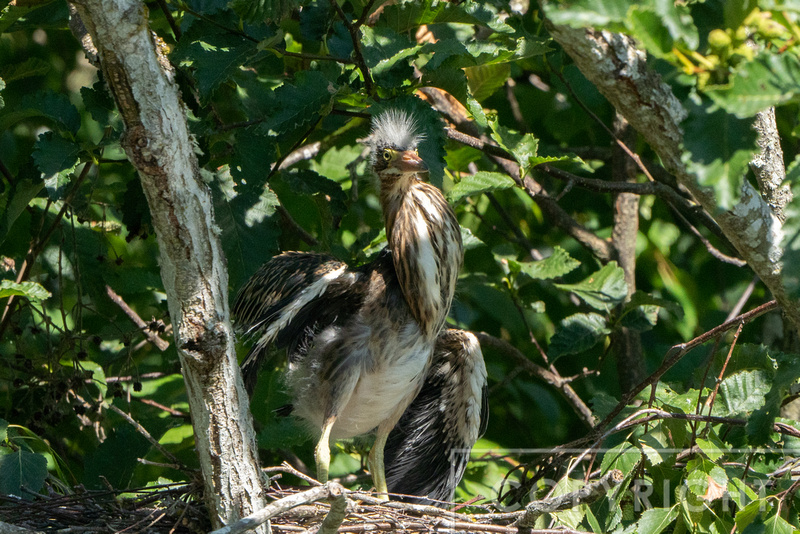  On Day 22, I witnessed my first short flight. At this stage, they could only fly a very short distance, and only to a lower elevation:
On Day 22, I witnessed my first short flight. At this stage, they could only fly a very short distance, and only to a lower elevation:
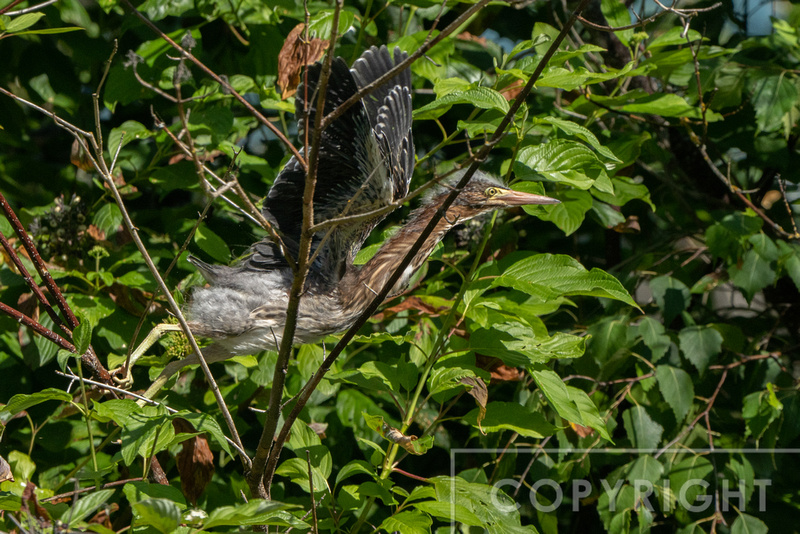  Since they could only fly down, they had to climb back up to the nest. This one was trying to navigate his way back up:
Since they could only fly down, they had to climb back up to the nest. This one was trying to navigate his way back up:
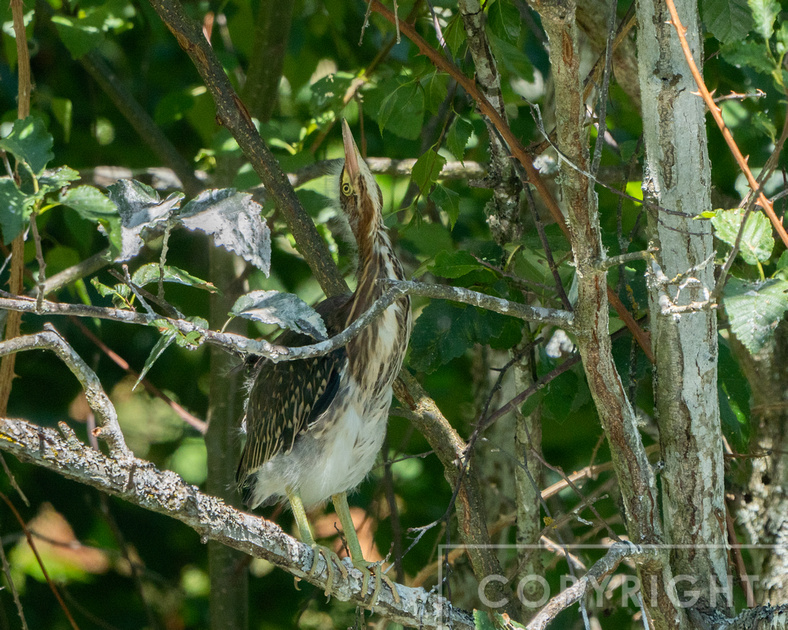  Day 23, the nest was still their home base. They would return back for a rest after venturing to the outer branches of the nest tree:
Day 23, the nest was still their home base. They would return back for a rest after venturing to the outer branches of the nest tree:
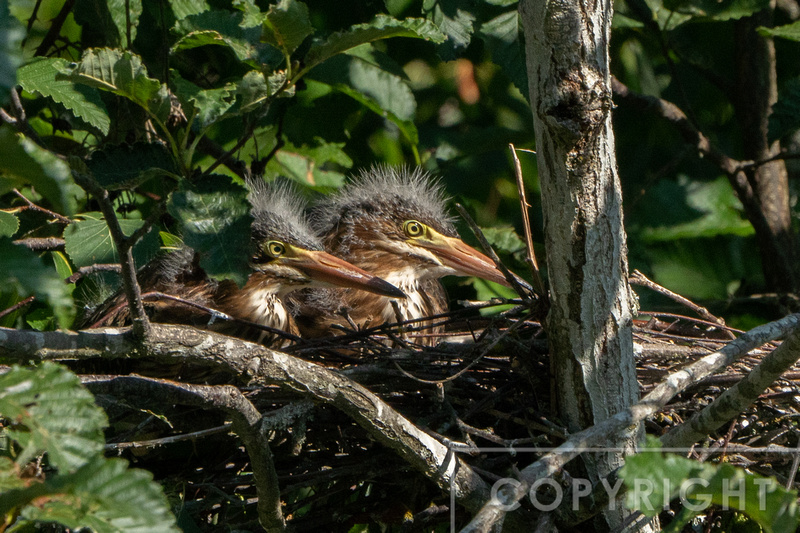  Day 24, they are becoming more aware of the world. In this case, a Kingfisher was flying by and making quite a racket:
Day 24, they are becoming more aware of the world. In this case, a Kingfisher was flying by and making quite a racket:
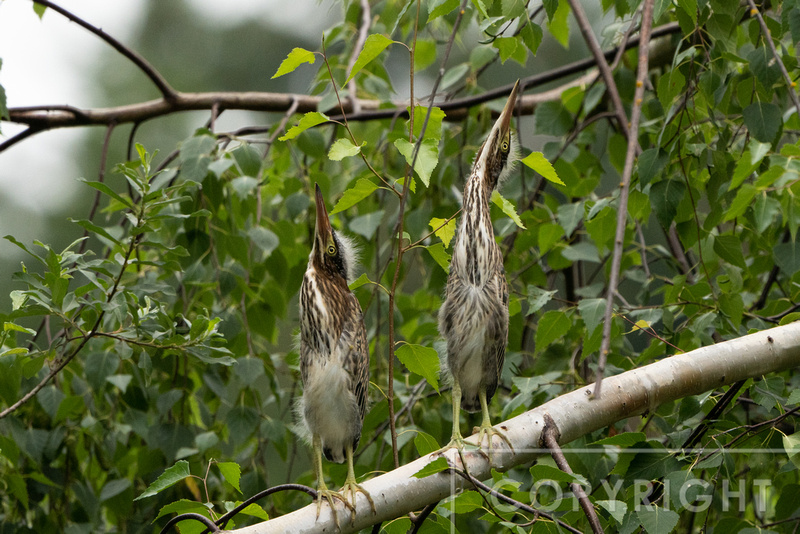  On day 24, the nest was still their home base:
On day 24, the nest was still their home base:
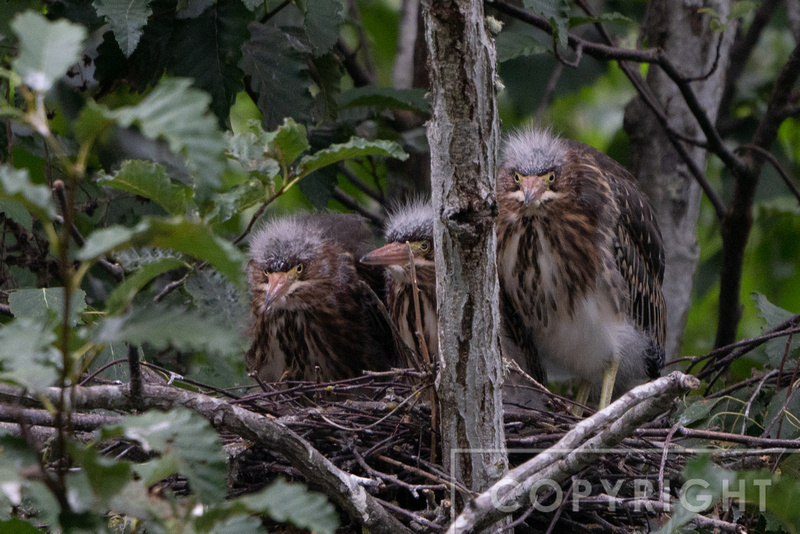  Another short flight, again, not yet able to fight gravity:
Another short flight, again, not yet able to fight gravity:
 Day 25 - This very proud little guy flew all the way to a floating log. It was my first time seeing them fly away from the nest tree:
Day 25 - This very proud little guy flew all the way to a floating log. It was my first time seeing them fly away from the nest tree:
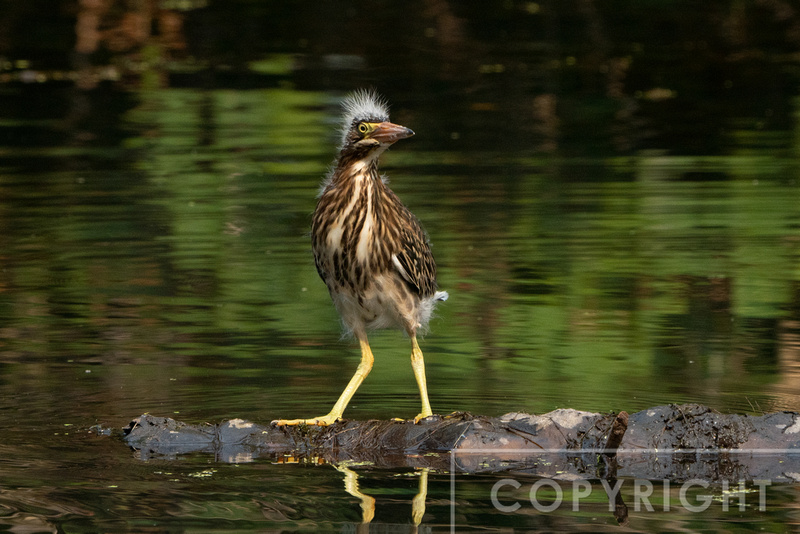  Drinking water, likely the first time, and learning how to hunt:
Drinking water, likely the first time, and learning how to hunt:
 One of the siblings was not as fortunate: it likely did not understand the properties of water, and learned pretty quickly that you cannot stand on it:
One of the siblings was not as fortunate: it likely did not understand the properties of water, and learned pretty quickly that you cannot stand on it:
 This poor little one spent the next hour up on a sunny branch drying out its wings:
This poor little one spent the next hour up on a sunny branch drying out its wings:
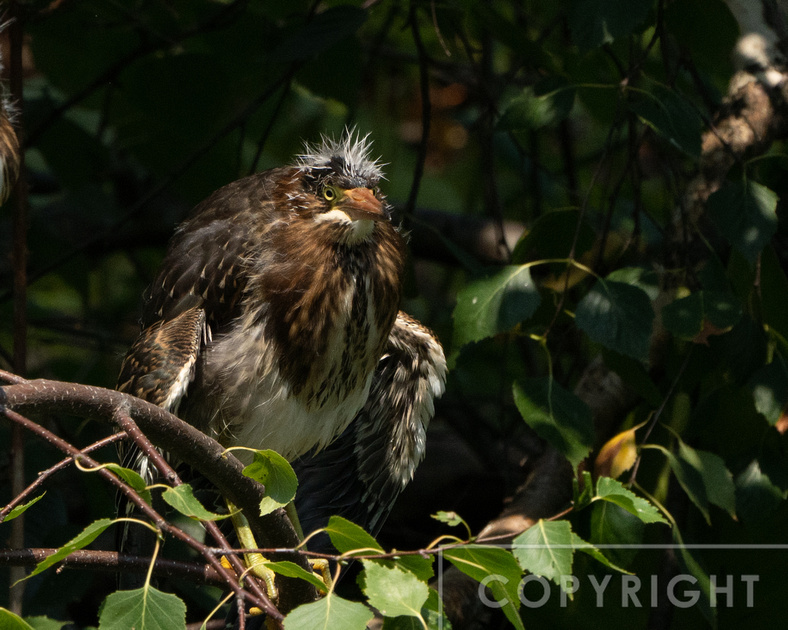  Day 26 - The chick on the left had caught a Dragonfly, but the one on the right decided to try to steal it away:
Day 26 - The chick on the left had caught a Dragonfly, but the one on the right decided to try to steal it away:
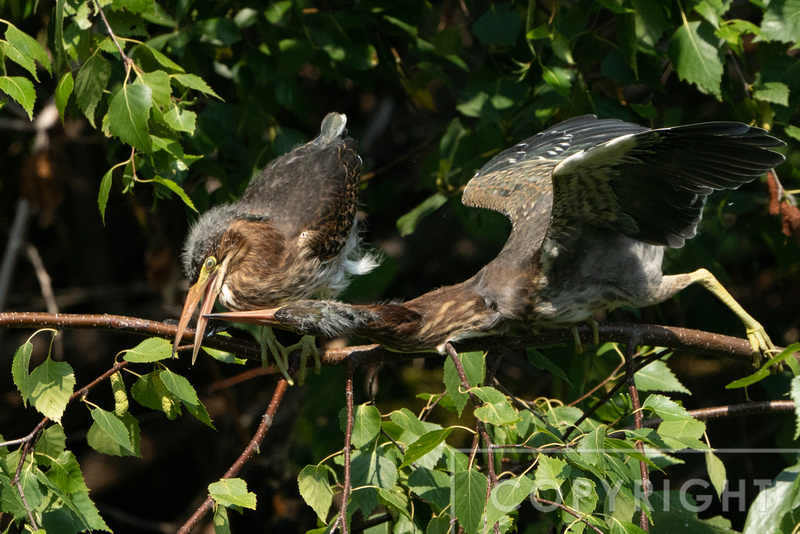  The were still hanging out pretty closely together, but no longer in the nest:
The were still hanging out pretty closely together, but no longer in the nest:
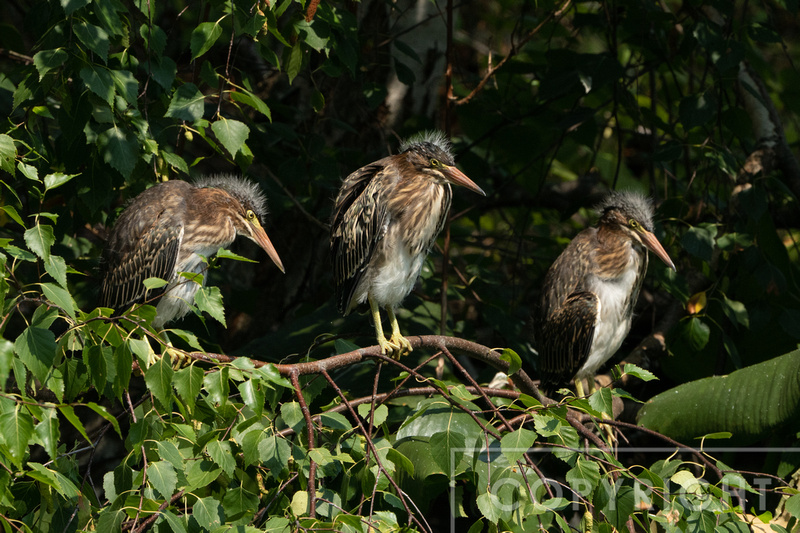  Day 27 - When I arrived in the morning I could not find the chicks. I finally realized that all three were in the huge Cottonwood tree on the other side of the river from the nest tree. They all had the hang of flying a distance:
Day 27 - When I arrived in the morning I could not find the chicks. I finally realized that all three were in the huge Cottonwood tree on the other side of the river from the nest tree. They all had the hang of flying a distance:
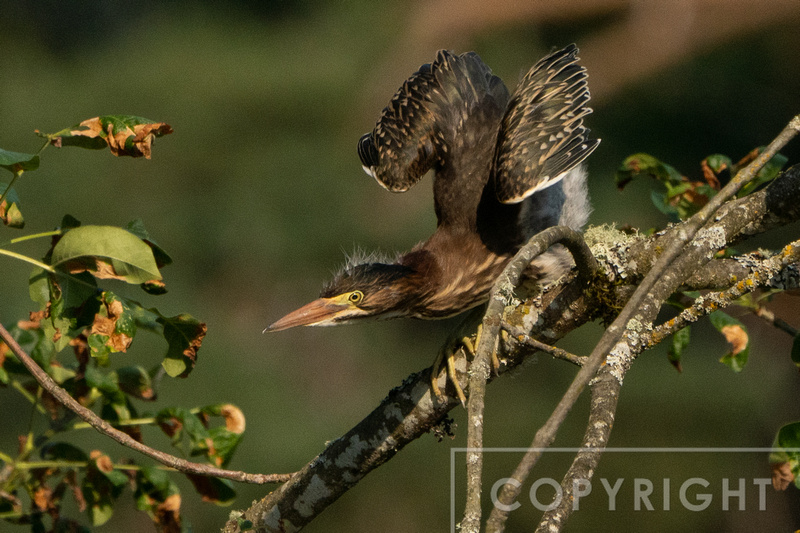  Two of the chicks flew off, but one stayed to explore the tree and environs. First order of business was practicing fishing:
Two of the chicks flew off, but one stayed to explore the tree and environs. First order of business was practicing fishing:
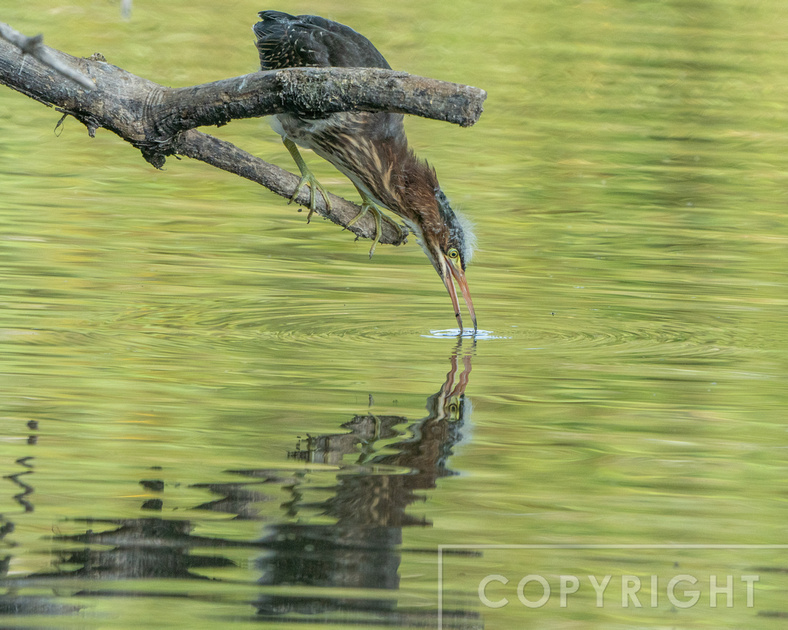  One trick is learning what to fish for:
One trick is learning what to fish for:
 As the chick proceeded to explore the tree, I set up my tripod nearby to follow its progress:
As the chick proceeded to explore the tree, I set up my tripod nearby to follow its progress:
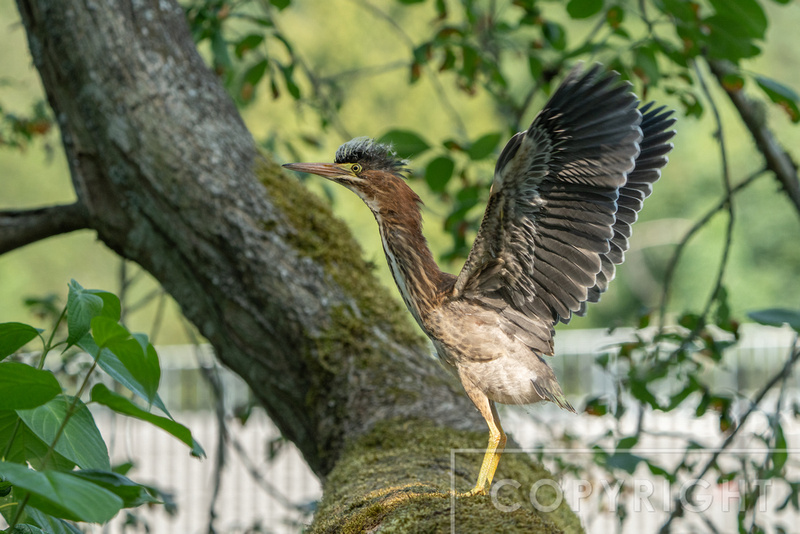  It also afforded me a one time opportunity for closeups. As the chick explored the tree, it had no idea I was quietly standing nearby (about 20 feet away):
It also afforded me a one time opportunity for closeups. As the chick explored the tree, it had no idea I was quietly standing nearby (about 20 feet away):
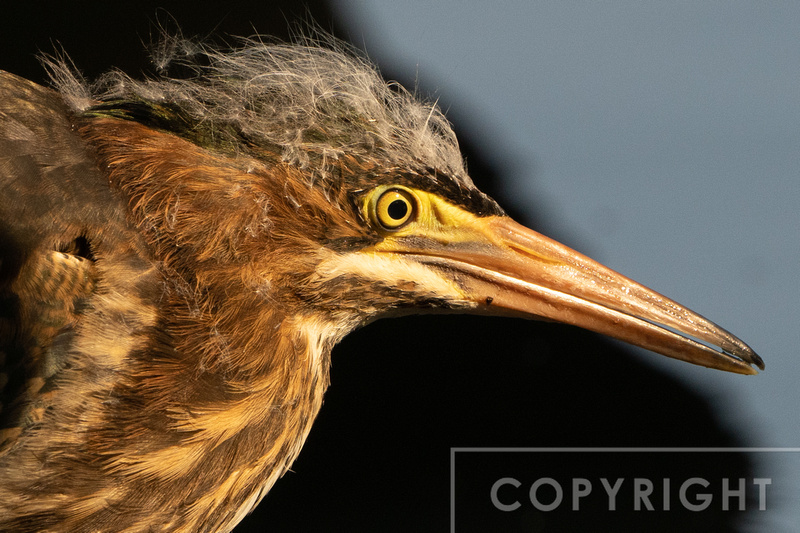  At one point he stared right at me, but I did not move a muscle, so he did not get frightened off:
At one point he stared right at me, but I did not move a muscle, so he did not get frightened off:
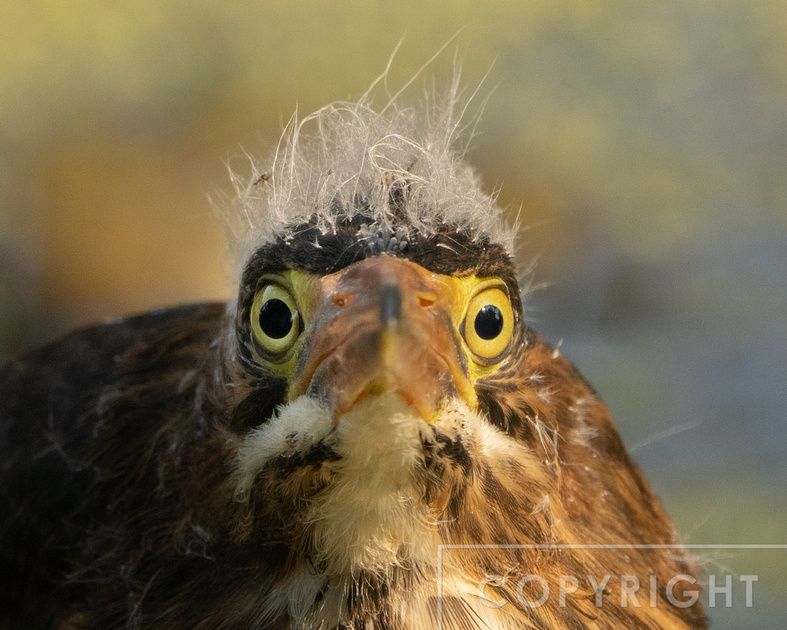  The chick explored the tree for another 15 minutes, but when it was ready to leave, I got my first shot of a chick flying upward, now able to defy gravity:
The chick explored the tree for another 15 minutes, but when it was ready to leave, I got my first shot of a chick flying upward, now able to defy gravity:
  Day 28, one month old and still practicing that all important hunting skill:
Day 28, one month old and still practicing that all important hunting skill:
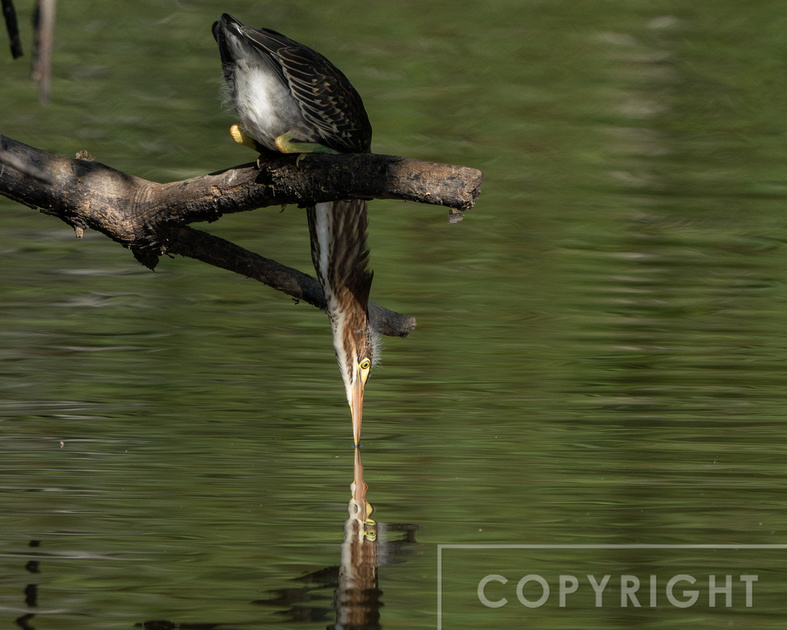  They were getting better and better at catching Dragonflies:
They were getting better and better at catching Dragonflies:
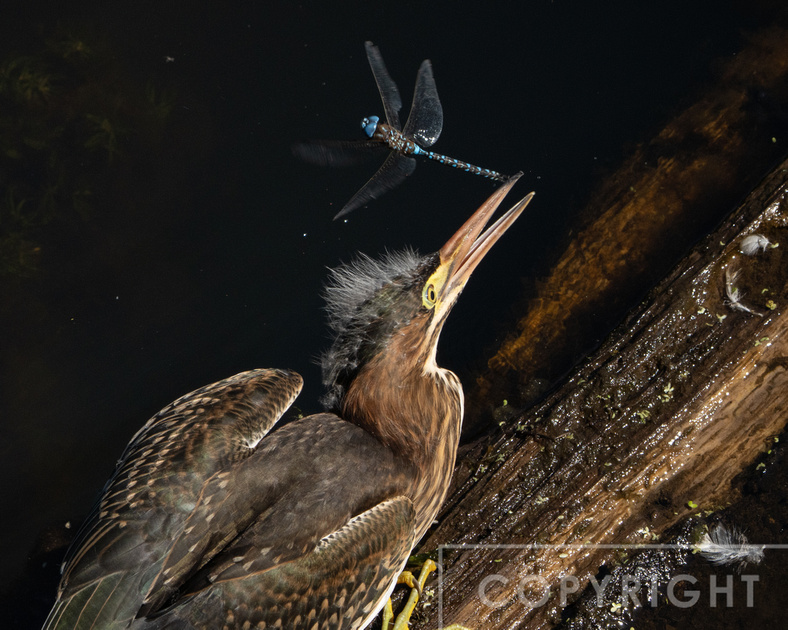  By Day 29, they were venturing farther and farther from the nest, and therefore harder and harder to photograph. But I was left with the great satisfaction that I got to watch these three chicks grow from hatching to fledging. I will likely never get an opportunity like this again, since it is very rare to have good visibilty into a Green Heron nest. But, I will return to the area next year in my kayak to get to see the Herons again. Have a safe flight south little ones!
By Day 29, they were venturing farther and farther from the nest, and therefore harder and harder to photograph. But I was left with the great satisfaction that I got to watch these three chicks grow from hatching to fledging. I will likely never get an opportunity like this again, since it is very rare to have good visibilty into a Green Heron nest. But, I will return to the area next year in my kayak to get to see the Herons again. Have a safe flight south little ones!
By the second week, we were starting to get some really good views of the chicks. They were still tied to the nest, but big enough so that we could see them. By the end of week two, they were starting to get more adventurous, wondering if there was a world beyond the nest.
On day 8 they were still very downy, but starting to develop feathers:
  They also were trying out those wings, hoping to figure out what these appendages were for:
They also were trying out those wings, hoping to figure out what these appendages were for:
  The challenge of photographing chicks in a nest is the uneven light. Sun becomes your enemy. On day 8 we had some clouds, enabling us to get better video:
The challenge of photographing chicks in a nest is the uneven light. Sun becomes your enemy. On day 8 we had some clouds, enabling us to get better video:
 Day 9 also had some clouds, enabling a more even exposure. You can see the beginnings on feathers on those wings:
Day 9 also had some clouds, enabling a more even exposure. You can see the beginnings on feathers on those wings:
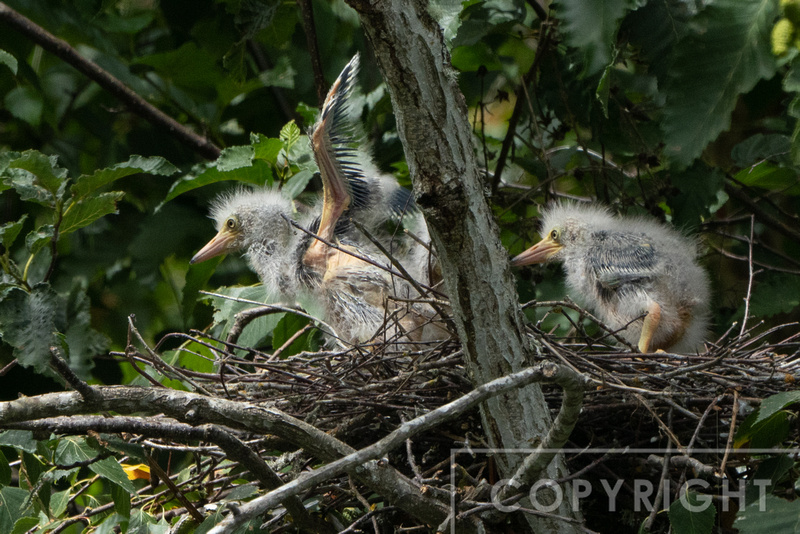  We started getting some good views of the chicks feeding. They grab onto the parent's beak and pull it down, forcing the parent to regurgitate the food:
We started getting some good views of the chicks feeding. They grab onto the parent's beak and pull it down, forcing the parent to regurgitate the food:
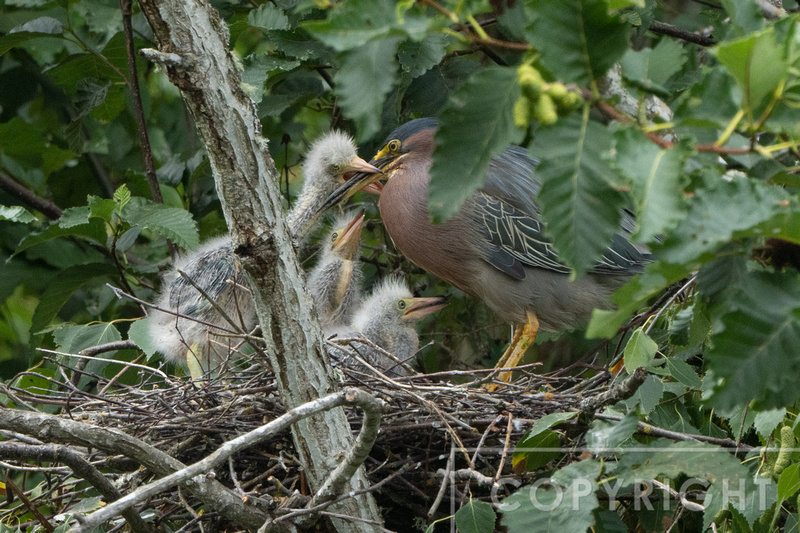  This is the best video I have of a feeding. There are two separate feedings in this one video:
This is the best video I have of a feeding. There are two separate feedings in this one video:
 Day 10, the chicks are still hanging out under parent:
Day 10, the chicks are still hanging out under parent:
  For most of the other videos, the soundtrack was removed, but for this one it was kept it in to show what the birds were reacting to:
For most of the other videos, the soundtrack was removed, but for this one it was kept it in to show what the birds were reacting to:
 On day 9, we saw many instances of the parents refusing to feed the chicks. Had the soundtrack been kept in this video, you would have heard me gasp. The video was slowed down to allow a better view of the interaction:
On day 9, we saw many instances of the parents refusing to feed the chicks. Had the soundtrack been kept in this video, you would have heard me gasp. The video was slowed down to allow a better view of the interaction:
 It is not clear why the parents went to the nest at all, because they did nothing but block the chicks from trying to feed:
It is not clear why the parents went to the nest at all, because they did nothing but block the chicks from trying to feed:
 This is a good example of what we were dealing with when the sun came out. It is much harder to see with the light and dark areas:
This is a good example of what we were dealing with when the sun came out. It is much harder to see with the light and dark areas:
 A favorite moment, as the chicks were learning to explore their world:
A favorite moment, as the chicks were learning to explore their world:
 Day 11, and the chicks are stretching out those growing wings:
Day 11, and the chicks are stretching out those growing wings:
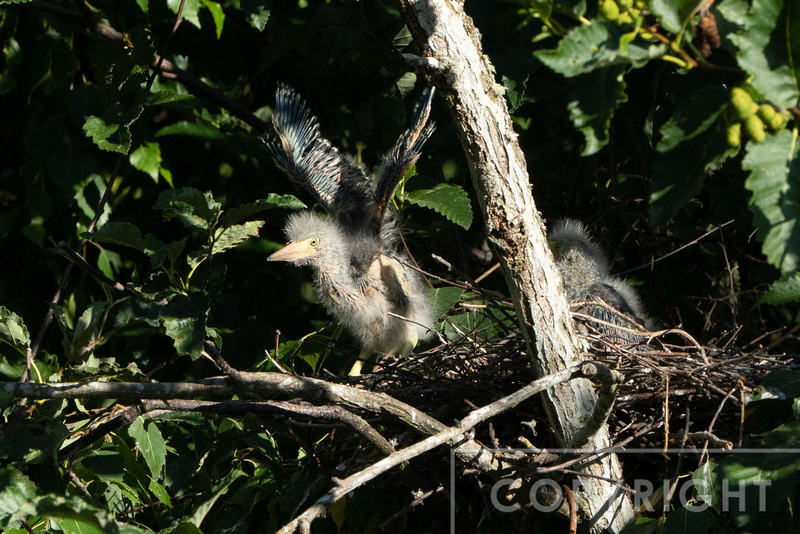  You can see the color starting to develop in those wing feathers:
You can see the color starting to develop in those wing feathers:
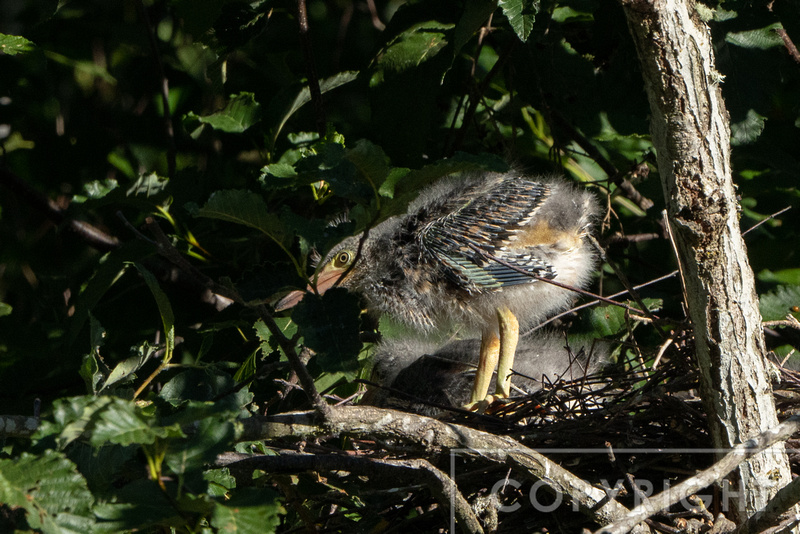  Day 12, it was so cute watching the chicks interact:
Day 12, it was so cute watching the chicks interact:
  They are getting a better and better idea what to do with those wings:
They are getting a better and better idea what to do with those wings:
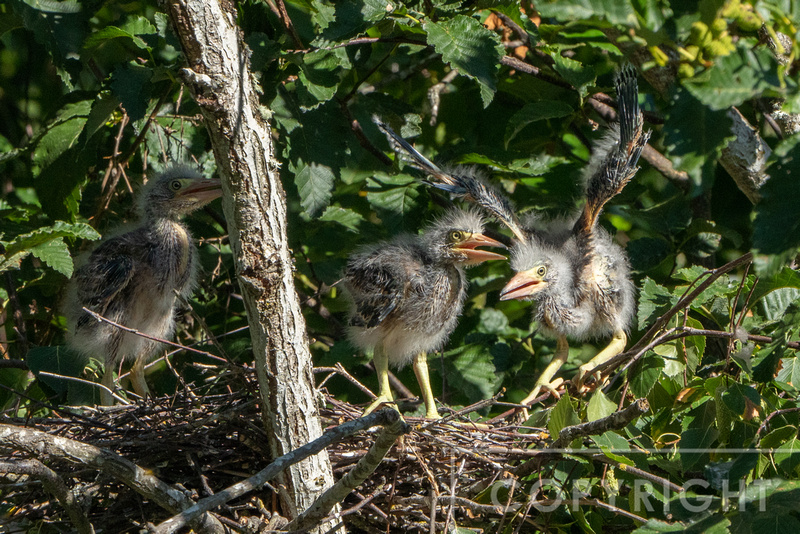  When the wings are not outstretched, the chicks still look so young:
When the wings are not outstretched, the chicks still look so young:
  There are a number of interesting things in this video. The chicks are aware that the second parent has arrived, but it does not stop them from trying to get a feeding from the first parent. Also, it is always interesting to see how the parents greet each other:
There are a number of interesting things in this video. The chicks are aware that the second parent has arrived, but it does not stop them from trying to get a feeding from the first parent. Also, it is always interesting to see how the parents greet each other:
 Starting to venture a bit out of the nest:
Starting to venture a bit out of the nest:
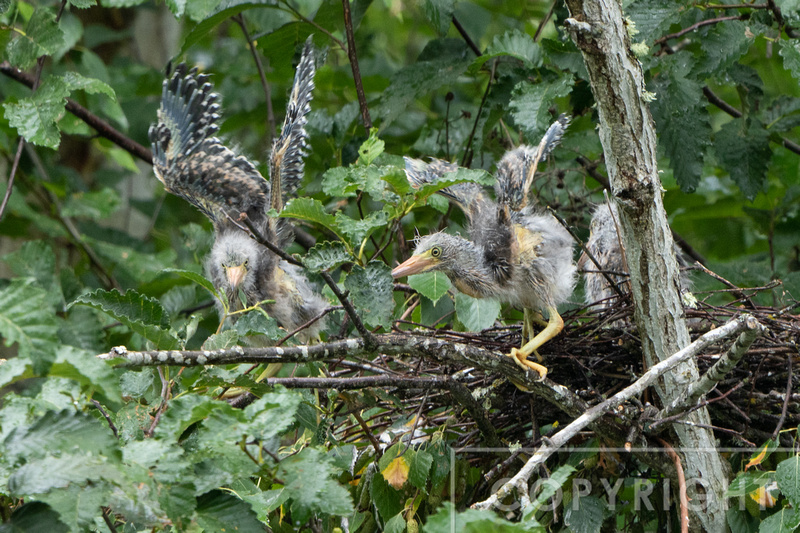  Getting comfortable with the idea of being out of the nest:
Getting comfortable with the idea of being out of the nest:
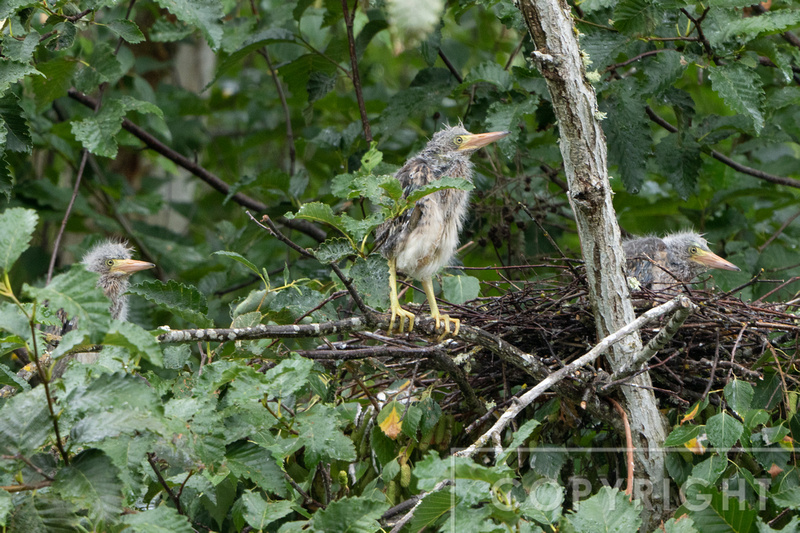  Getting soooo big:
Getting soooo big:
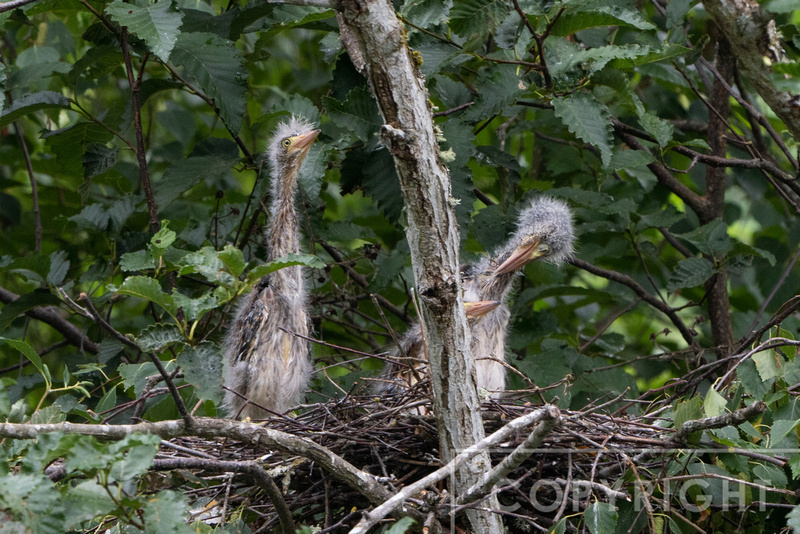  The chicks were getting more and more active, and preparing for that all important step up and out of the nest:
The chicks were getting more and more active, and preparing for that all important step up and out of the nest:
 Day 13, on the cusp of learning to leave the nest:
Day 13, on the cusp of learning to leave the nest:
  And they are out:
And they are out:
 Truly branching out. The chicks ventured about 15 feet away from the nest:
Truly branching out. The chicks ventured about 15 feet away from the nest:
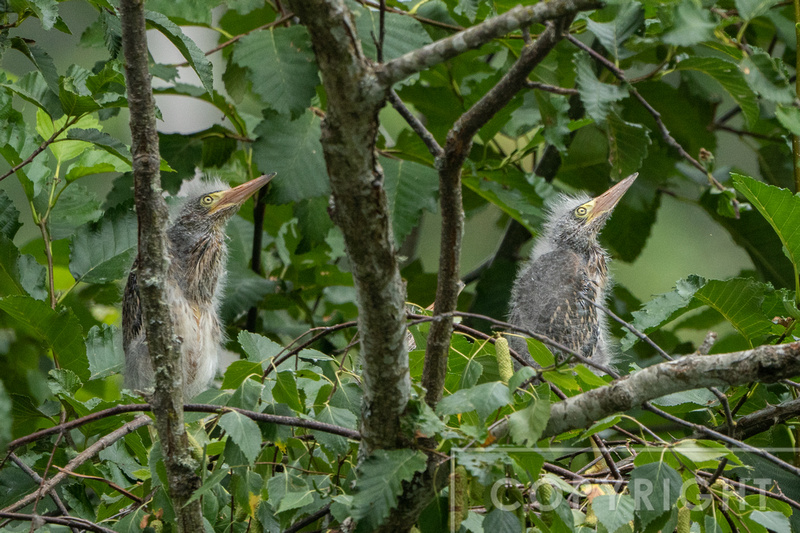  Week two was highly entertaining. They went from little fuzz balls just developing feathers, to teenagers branching out. We were so fortunate to have good views into the nest to be able to document all these changes.
Week two was highly entertaining. They went from little fuzz balls just developing feathers, to teenagers branching out. We were so fortunate to have good views into the nest to be able to document all these changes.
For the first time in my life, I found a Green Heron nest. They are notoriously difficult to find, because they are normally buried deep in a tree, and very difficult to see. I was kayaking in June, and saw two Green Herons mating in a tree. Lo and behold, they were in a nest.
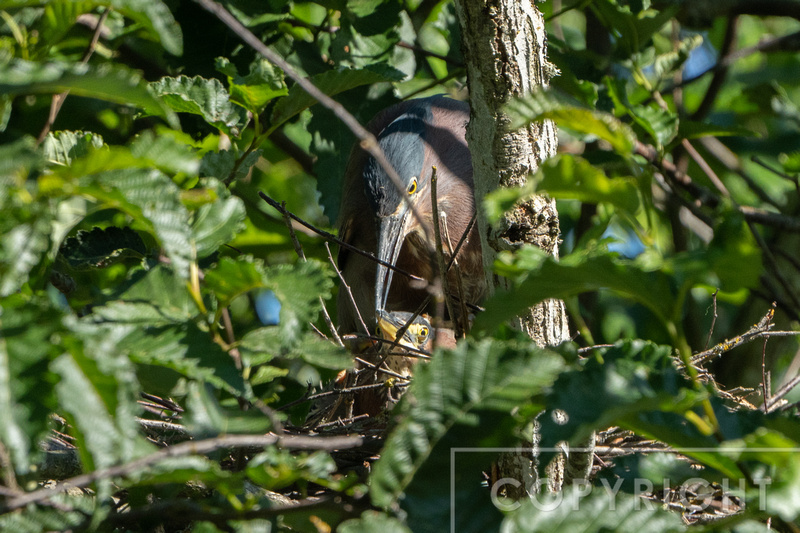  I then did the math to figure out when the chicks should be hatching. My calculation was that the first possible time to see the chicks was on July 6th. Also crucial to this caluculation was finding a good observation spot. The kayak was too close to the nest and too disruptive. My friend Deena and I figured out that there was a spot on the nearby bank that was near the nest site, that was a perfect observation spot. It was on the south bank of the river (nest was on the north bank), so the lighting would be good, and we were far enough away to be non-disruptive. Being on land also allowed us to set up tripods, which makes video possible. Amazingly, there was pretty good visibility into the nest, which is almost unheard of.
I then did the math to figure out when the chicks should be hatching. My calculation was that the first possible time to see the chicks was on July 6th. Also crucial to this caluculation was finding a good observation spot. The kayak was too close to the nest and too disruptive. My friend Deena and I figured out that there was a spot on the nearby bank that was near the nest site, that was a perfect observation spot. It was on the south bank of the river (nest was on the north bank), so the lighting would be good, and we were far enough away to be non-disruptive. Being on land also allowed us to set up tripods, which makes video possible. Amazingly, there was pretty good visibility into the nest, which is almost unheard of.
We were not able to get to the nest until July 8th, but this is what we found:
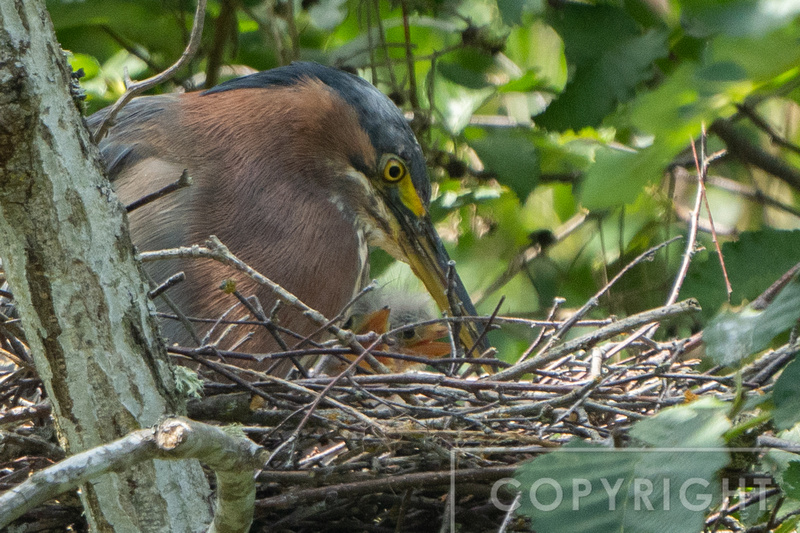  There is a good chance these chicks were a day or two old at that point, but for record keeping purposes, this was referred to this as day 1. We were able to observe our first feeding. Watch the video all the way to the end:
There is a good chance these chicks were a day or two old at that point, but for record keeping purposes, this was referred to this as day 1. We were able to observe our first feeding. Watch the video all the way to the end:
 The adult will regurgitate the food, then re-swallow anything that is not eaten. Seems pretty efficient!
The adult will regurgitate the food, then re-swallow anything that is not eaten. Seems pretty efficient!
Days 2 and 3 were challenging, photographically speaking. There were very few good views of the chicks.
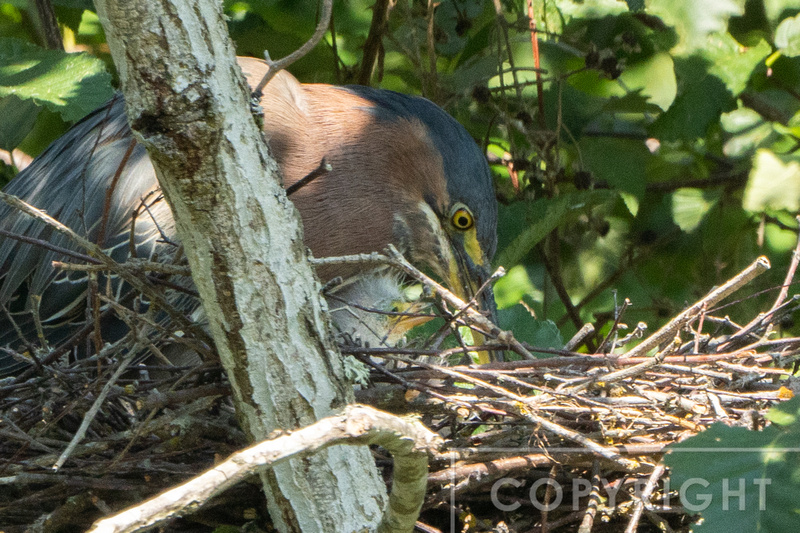  There may not have been many good stills of the chicks that day, but we started observing what I referred to as the "Changing of the Guard". Mom and Pop trading places:
There may not have been many good stills of the chicks that day, but we started observing what I referred to as the "Changing of the Guard". Mom and Pop trading places:
 Day 3 was also not a great day for chick sightings, but day 4 was when we finally started getting some good views:
Day 3 was also not a great day for chick sightings, but day 4 was when we finally started getting some good views:
  We now knew that there were 3 chicks. We also got our first glimpse of how the chicks communicate to the parent that they are hungry:
We now knew that there were 3 chicks. We also got our first glimpse of how the chicks communicate to the parent that they are hungry:
 By Day 5, the chicks were getting big enough for us to see them really well. Look at the size of that lower jaw!
By Day 5, the chicks were getting big enough for us to see them really well. Look at the size of that lower jaw!
  By day 5, we were also getting really good glimpses into how the parents interact with each other:
By day 5, we were also getting really good glimpses into how the parents interact with each other:
 It would be great to know what this behavior is about. The departing parent bites at the beak of the arriving parent, then runs its beak along the length of the bird. We saw this behavior repeatedly, really interesting!
It would be great to know what this behavior is about. The departing parent bites at the beak of the arriving parent, then runs its beak along the length of the bird. We saw this behavior repeatedly, really interesting!
Day 6 provided a chance for a good clear view of the chicks begging for food.
  We also got good views of the chicks feeding:
We also got good views of the chicks feeding:
 The chick was not able to swallow that entire fish, but he sure tried.
The chick was not able to swallow that entire fish, but he sure tried.
Day 7, the chicks are getting so big:
  One of the best views of a fish being regurgitated:
One of the best views of a fish being regurgitated:
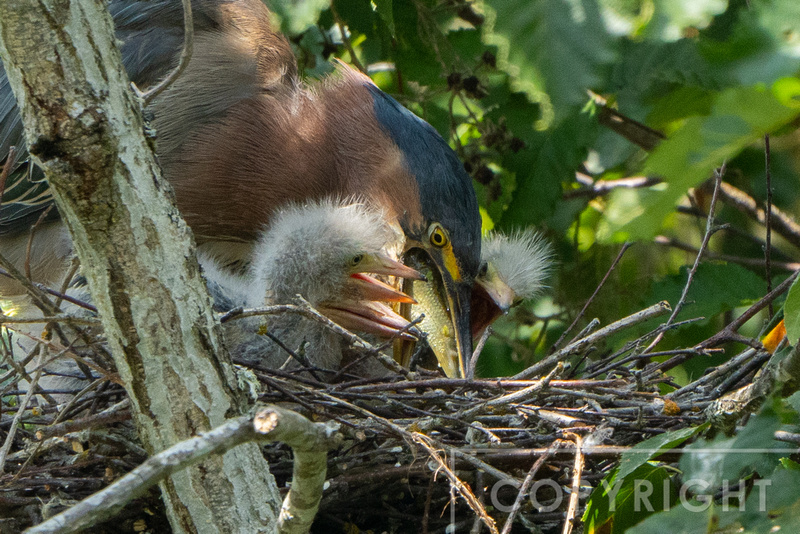  Another changing of the guard on Day 7, and our first chance to see how the chicks keep from smelling up their nest with poop. It was especially cute since the chick chose to poop betweem mama's legs:
Another changing of the guard on Day 7, and our first chance to see how the chicks keep from smelling up their nest with poop. It was especially cute since the chick chose to poop betweem mama's legs:
 I will post a blog for each week of their development. It was a total joy and an honor to follow this very special nest.
I will post a blog for each week of their development. It was a total joy and an honor to follow this very special nest.
I have been fascinated by murmuration activity from the first time I heard about it. There are lots of spectacular videos on YouTube about Starling murmurations. But, there is another bird who murmurates regularly: theDunlin, a little shorebird.
  Peregrine Falcons love to predate on Dunlin, so the Dunlin have developed this great strategy to battle the fastest bird on earth.
Peregrine Falcons love to predate on Dunlin, so the Dunlin have developed this great strategy to battle the fastest bird on earth.
 As far as I can tell, the above video is of a "practice session". There was no predator chasing them. But, the Peregrine Falcon are always nearby, waiting to pounce:
As far as I can tell, the above video is of a "practice session". There was no predator chasing them. But, the Peregrine Falcon are always nearby, waiting to pounce:
  Once the Peregrine attacks, the murmurations become frantic:
Once the Peregrine attacks, the murmurations become frantic:
 The thing that surprised me about this video, however, was that there were two birds attacking the Dunlin. One, I believe was a Peregrine, but the other was a Northern Harrier, a very common Hawk in this area:
The thing that surprised me about this video, however, was that there were two birds attacking the Dunlin. One, I believe was a Peregrine, but the other was a Northern Harrier, a very common Hawk in this area:
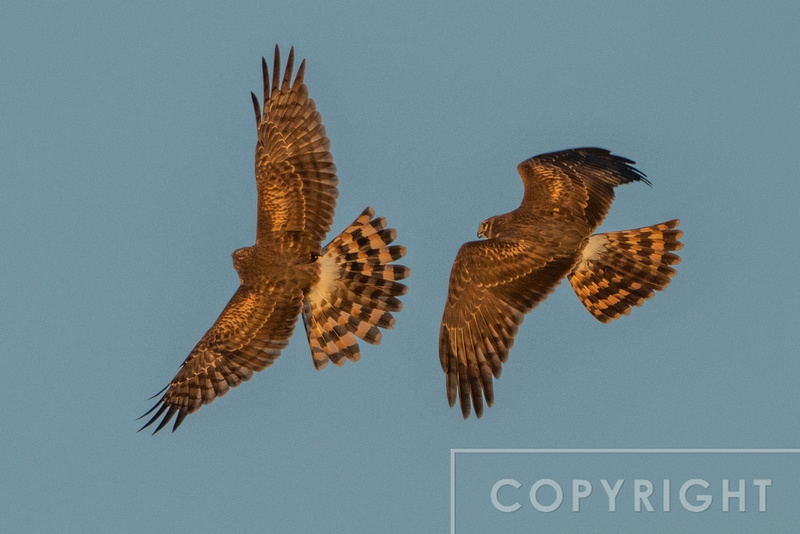  The Harriers are very easy to spot from a distance because of the white patch on their tails. So, when I slowed up the video of the hawks attacking the Dunlin, I was amazed to see a Harrier in there:
The Harriers are very easy to spot from a distance because of the white patch on their tails. So, when I slowed up the video of the hawks attacking the Dunlin, I was amazed to see a Harrier in there:
 I was amazed. This was the first time I had witnessed this activity. I never think of Harriers as being particularly fast flyers, so I have no idea if they are ever successful in catching a Dunlin. Their "usual" prey are mice and voles. But, yet again, the natural world has surprised me. Not the first time, and certainly not the last.
I was amazed. This was the first time I had witnessed this activity. I never think of Harriers as being particularly fast flyers, so I have no idea if they are ever successful in catching a Dunlin. Their "usual" prey are mice and voles. But, yet again, the natural world has surprised me. Not the first time, and certainly not the last.
|
Archive
January
February
March
April
May
June
July
August
September
October
November
December
|
|
|
|
|
|
January
February
(2)
March (2)
(5)
April (5)
May
June
July
August
September
October
November
December
|
January
(1)
February (1)
March
April
May
June
July
August
September
October
November
December
|
January
February
March
(1)
April (1)
May
June
July
August
September
October
November
December
|
January
February
March
April
May
June
July
August
September
October
November
December
|
|


















































